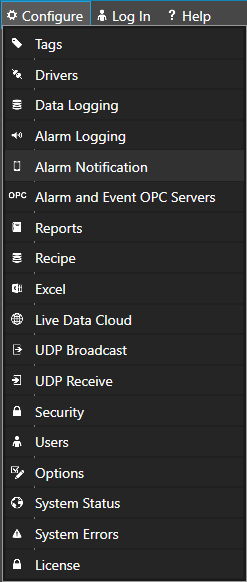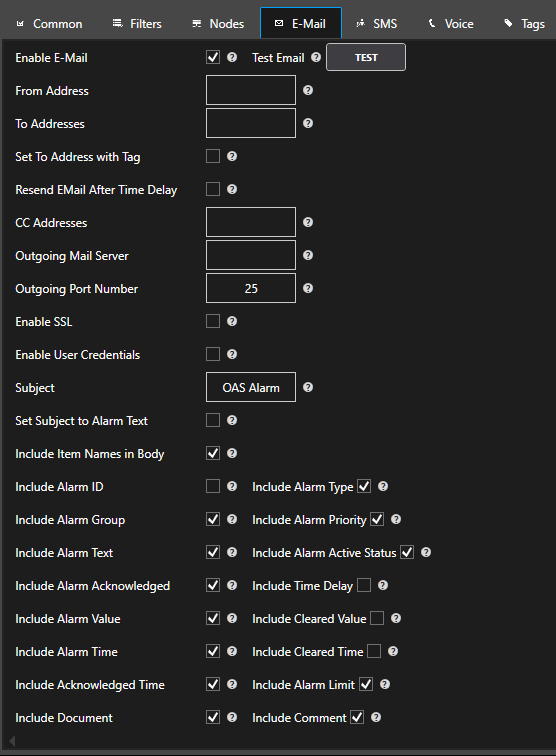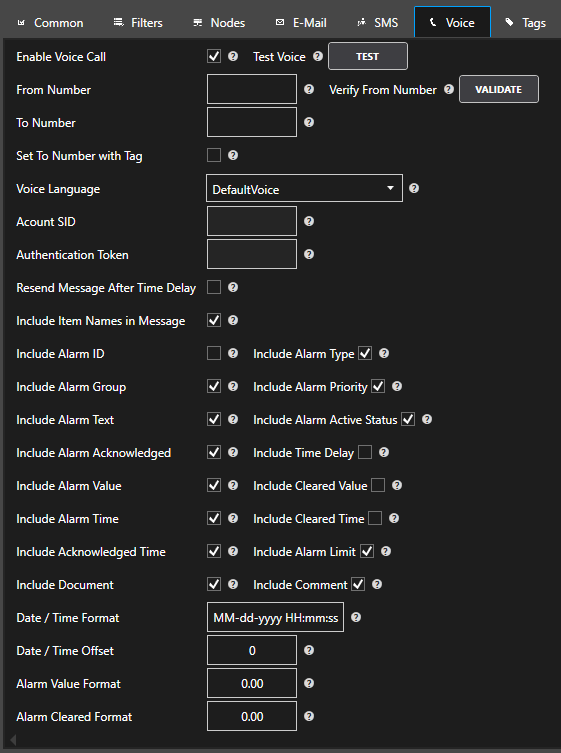If the cell phone provider can provide an email address to receive texts setup to send an email.
To send a text message to someone on AT&T in the To Address, just enter the 10 digit phone number @txt.att.net. Example 5555551234@txt.att.net.
Frequently Asked Questions – Alarm Notification
Create a new Boolean Tag with the tag name EscalateAlarm.
Enable the Digital Alarm limit in this new Tag with a Time Delay of ? Seconds.
Under the Tags tab of an existing or new Alarm Notification group the property “Set Tag When Alarm Active and Not Acknowledged” to a Boolean Tag with the Data Source of Value.
EscalateAlarm.AlarmStatusDigital can then be used to enable a second Alarm Notification monitoring the same alarms of the first Alarm Notification group with the Activate with Tag property in the second Alarm Notification Group.
Note: Under Configure-Options-Alarms uncheck “Update Alarm Status Immediately Without Alarm Time Delay”.
This will then enable the second alarm notification group when the alarms monitored in the first group.
Videos – Alarm Notification
Alarm Logging and Notification
Alarm Logging to SQL Server, Oracle, MySQL, PostgreSQL, SQLite, and more. Send alarm notifications via Email, SMS, or voice.
Alarm Limits
How to setup alarm limits in real-time tag configuration.
Send Alarm Emails
How to setup Alarm Notification to send emails for specific alarms.
Alarm Escalation
How to escalate alarms over time.
Alarm Notification Programmatic Interface
Use the OPC Systems component in your Visual Studio application to programmatically modify alarm notification groups. Refer to the FormConfigureAlarmNotification Form in the WinForm Example Code example for an example and how to add and modify alarm logging groups.
Refer to the Programmatic Access Alarm Notification Groups section in the Programmatic Interface – .NET Programmatic Configuration topic for all of the method syntax.
Alarm Notification CSV Export and Import
All notification groups can be exported to a CSV file by right clicking on the Local service and select Export CSV.
Note: You cannot have Excel open with the CSV file during the import as Excel will lock the file for exclusive use. First close the file in Excel, and then proceed with the import.
Getting Started – Alarm Notification
The Alarm Notification feature is used to summarize alarm totals and send e-mails based on specified filter criteria of alarm conditions.
In order to utilize alarm notification you must first define the Tag Alarm Limits as described in Configure Tags of this Quick Start section. For a complete list of all Alarm Notification properties refer to the OAS Configuration – Alarm Notification section in this help file.
Step 1
 Start Configure OAS application.
Start Configure OAS application.
Load the DemoTags Tag configuration or use the new Tag configuration you have created.
Step 2
Select Configure-Alarm Notification.
Step 3
Select the Local OAS Service by selecting the Select button next to the Network Node drop down.
![]()
Step 4
Enter the Notification Group Name of Simulation in the field in the upper right.
![]()
Step 5
Check Notification Active in the Common Properties Tab.
![]()
Step 6
Select the Filters Tab.

Notice how you can define filtering based on Alarm Priority, Alarm Groups, and Alarm Types.
Step 7
Select the notification type your would like to set up – Email, SMS or Voice. To use SMS or Voice as a notification type you will need to use the Twilio service.
7.1 For Email notifications select the Email tab
You can define to send alarms that meet the filter criteria to an e-mail account. Use a semicolon to separate multiple e-mail addresses.
7.2 For SMS notifications select the SMS tab

To trial the functionality you can use the demo mode to send 10 notifications. To use SMS as a notification type you will need to use the Twilio service.
7.3 For Voice notifications select the Voice tab

To trial the functionality you can use the demo mode to send 10 notifications. To use Voice as a notification type you will need to use the Twilio service.
Step 8
Select the Tags Tab

With the Tags properties you can assign to automatically write alarm statistics to Open Automation Software Tags. Useful to drive an external alarm horn through a PLC or display how many alarms are currently active.
Step 9
Select Configure-Tags and add a Boolean Tag with the name Alarm Is Active.
Add an Integer Tag with the name Number Of Alarms Active.
Add an Integer Tag with the name Number Of Alarms In Last 24 Hours.
Step 10
Return to Configure-Alarm Notification:
- Enable the property to Set Tag When Alarm Active
Assign the Tag name Alarm Is Active.Value - Enable the property to Set Integer Tag with Alarm Active Count
Assign the Tag name Number Of Alarms Active. - Enable the property to Set Integer Tag with Number Of Alarms In A Given Period
Assign the Tag name Number Of Alarms In Last 24 Hours
Step 11
Select the Add Group button at the top of the left pane to add the Alarm Notification group.
![]()
Step 12
Select the Save button on the toolbar at the top.

Step 13
Save the file DemoAlarmNotification.AlarmNotification in the directory C:OPCSystemsDemo.
You can specify for this configuration to load automatically when the Service starts using Configure-Options which is described also in this Training Guide.
Step 14
Return to Configure-Tags and select each tag and note that the current number of alarms and active state are updated automatically to the appropriate tag.
Overview – Alarm Notification
The OAS Alarm Notification feature is included as part of the Alarms .NET and Web Alarms products. If you want to develop server or desktop applications using WinForms, WPF or the Dotnet SDK then you would choose the Alarms .NET product. On the other hand, if you want to develop web-based applications with HTML and JavaScript the you would choose the Web Alarms product.
Both products give you the ability to configure alarm thresholds on any of your tags. This includes Digital, Low, Low Log, High, High High and Rate of Change alarm types with configurable parameters such as threshold value, delay, deadband, priority, alarm text, alarm group and more. By default, OAS stores the run-time alarm state in memory and allows you to configure alarm buffering in case of restart. OAS also provides alarm acknowledgement features through the alarm controls and its APIs.
The Alarm Notification feature allows you to send alarm notifications via E-mail, SMS or Voice. E-mail notifications are configured to send using an SMPT server. The SMS and Voice notifications are integrated with Twilio and require a Twilio account.
Alarm notifications work by configuring one or more Notification Groups. Each notification group is essentially a filter and any alarms that match the filter will trigger a notification for that alarm. This includes parameters such as alarm state, alarm type, priority and alarm group. You can create as many notification groups as you need.
Supported features:
- Customize which alarm details are included
- Dynamically set “To Address” using another Tag
- Dynamically set “Phone Number” using another Tag
- Repeat notification after time delay
- Prevent sending multiple notifications within configurable time period
- Acknowledge alarm by E-mail reply
View the Getting Started section on Alarm Notification to follow simple steps.
Other resources for Alarm Notification: Programmatically Access Configurations











